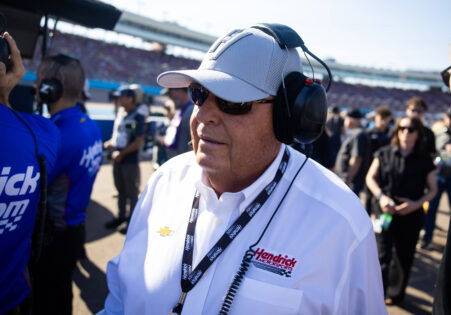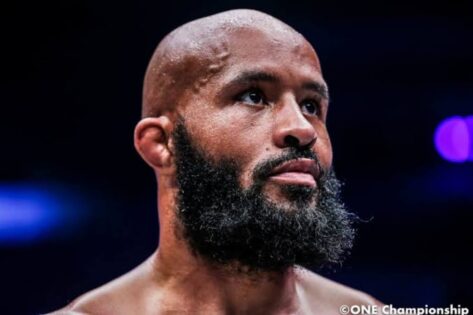It’s where legends are born (and sometimes lost) with memories dripping in confetti and speed. There’s something about that high bank roar of the Daytona International Speedway that screams Americana and nostalgia. Dale Earnhardt Jr. once said he needed a psychiatrist to sort through his emotions there, adding that his late father “Loved Daytona and loved winning… It’s hard not to think about that race,” even decades after Dale Earnhardt’s final lap of glory in 2001. It speaks to the heart and soul of NASCAR’s most storied track. Enter Rick Hendrick.
Lately, many things indicate that the emotional link is fraying. The track changes over the years have resulted in tighter packs, fewer daring passes, and a sense that the NASCAR they fell in love with is slipping away. That was exactly the tone struck by a top official at Rick Hendrick’s HMS this week. With a knowing smile and a half grin, he laid down a brutal reality check on the beloved track of Daytona.
HMS official reflects on how Daytona lost its edge
Over the years, Daytona has undergone major facelifts, none more impactful than its full repave in 2010-11. Before that, the track’s aging surface hadn’t seen a full resurface since it opened in 1959, aside from a top coat in 1978. But after the infamous pothole during the 2010 Daytona 500 halted the race for over two hours, officials tore the place up and rebuilt it from the lime rock base using polymer-enhanced asphalt. The result? A silky smooth, high-grip surface that made the cars stick like glue, killing tire fall off and, unintentionally, much of the unpredictability that once made Daytona thrilling.
Echoing the loss of Daytona’s identity due to all these changes, Alan Gustafson didn’t hold back. Having been Chase Elliott’s 2020 championship-winning crew chief and the voice behind Jeff Gordon’s reign from 2011-15, Alan still holds the old surface close to his heart. In a recent post-race interview at EchoPark, Alan recalled saying, “ I wish Daytona was like it used to be—before they repaved it. Remember 2008 or whenever that was? That rough surface, worn out, would be super fun. Because then you wouldn’t be able to do what you do at Talladega and Daytona, where everybody’s packed up so tight and you just can’t get an advantage.”
Gustafon’s nod to 2008 because it was one of the last years Daytona retained its original, edge-of-control character. The track hadn’t been repeated since 1978, and by the late 2000s, wear and tear, bumps, and tire heat made it a handling gauntlet. In early 2009, Dale Earnhardt Jr. publicly urged NASCAR to resurface Daytona, referring to its surface as old after more than three decades without a full resurface. He said, “The track is old. It’s a terrible time to ask anyone to pay a racetrack, but if anyone needs it, it’s probably Daytona.”
Even Jeff Gordon specifically pointed out that Daytona, unlike Talladega, demands precise handling due to its design. He says, “Talladega is not a handling track while Daytona is… At Daytona, the car must handle well through the corners.” Now, drivers often fall into long trains and gridlock. Racing feels more like save fuel sprints than let it all hang out duels. The story goes that NASCAR even removed restrictive plates in favour of tape, but the result is the same. Packing forming that dampens passing and excitement.
Part of the argument also revolves around legend versus legacy. Nobody embodied Daytona better than Dale Earnhardt, whose 1998 Daytona 500 win ended a nearly two-decade drought, famously added by a lucky Penny. That memory still resonates in the sports collective DNA. But the current surface and rule set seem designed for cautious strategy over raw horsepower, leaving many craving the intimidator era.
Statistically, the balance of power has shifted to. While Richard Petty still holds the untouchable seven Daytona 500 wins, modern drivers rarely repeat the dominance of the past. The recent back-to-back wins by William Byron in 2024 and 2025 are exceptions that prove the rule, fuel strategy and drafting partnerships now decide races far more than individual grit. Moreover, straight after Chase Elliott’s hometown win at Atlanta, Alan went on to say, “I just feel like the car, the pace, and the driver obviously (like what Chase did) make a little more of a difference here.”
Chase Elliott is rooting for teammate Alex Bowman’s long-awaited win
Chase Elliott wasted no time giving credit where it was due after his epic Atlanta Home win, stepping into the spotlight with a nod to teammate Alex Bowman’s clutch timing. In a post-race press conference buzzing with excitement, Elliot broke it down. He said, “ He (Bowman) and I both knew the only shot we had at that juncture was to line up and push and hope something worked in our favor. At that point it was too, one, one.” In other words, if Rick Hendrick’s wrecking crew wanted the win, it was going to take a one-two punch.
And punch it, they did. With 46 lead changes among 13 drivers, 2 red flags, and 10 caution flags saturating the Quaker State 400, Atlanta boiled over into pandemonium. On the final lap of 259, Bowman dropped in perfectly behind Elliott, giving him the shove that launched Elliott’s Chevy underneath Brad Keselowski for the lead and the win by a razor-thin 0.168 seconds. Elliot didn’t shy from acknowledging the delicate dance of strategy and loyalty. The No. 9 Driver went on to say, “Whether it was he or I, obviously, we both want to win. I recognize that he gave me a great shove.”
Meanwhile, Chase expressed genuine hope that Alex’s efforts would soon fall into place, noting that his teammate has endured a very punishing run of misfortune over the past month. Mr. Popular praised Bowman’s speed and persistence, genuinely hoping that a win could boost Alex into the playoffs. The Georgia native went on to say, “ It would be nice to see him grab a win and get in.”
Maybe Chase Elliott could return the favor and help out Alex Bowman in the future. As Elliott blazes ahead and pays it forward, voices like Alan Gustafson’s remind us of what’s being paved over. Maybe the sport doesn’t need to go back in time, but it sure could use a little of that old grit moving forward. And with the NASCAR Cup Series now heading to the streets of Chicago for the Grant Park 165, a new kind of challenge awaits.
The post Rick Hendrick’s Top Brass Gives Brutal Reality Check on Daytona’s Lost Identity appeared first on EssentiallySports.



